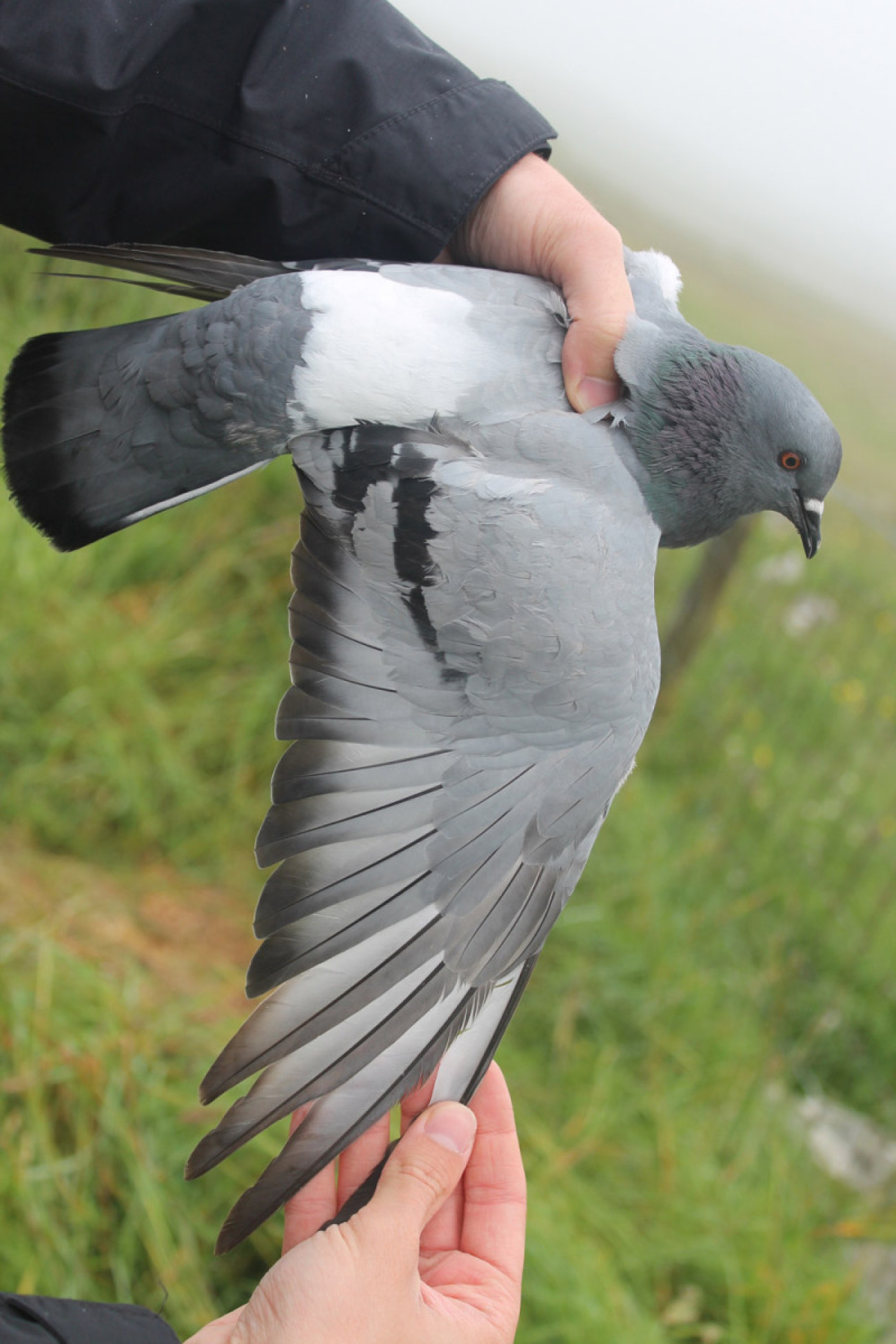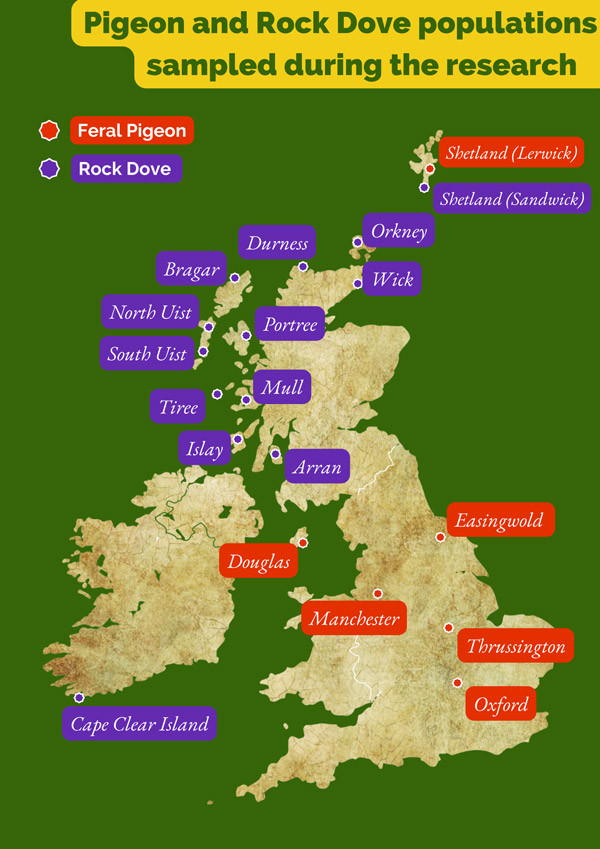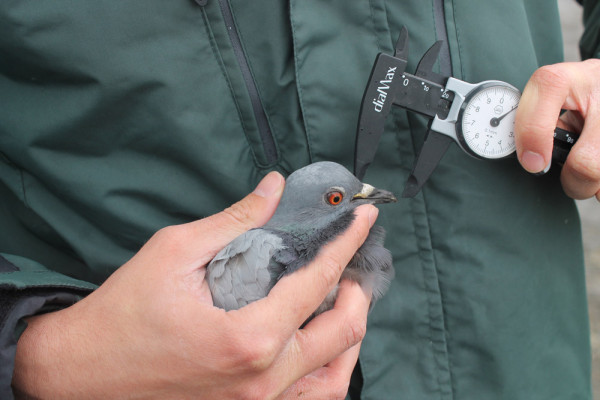
Wild Rock Doves: solving a genetic enigma
BTO ringer and DPhil student Will Smith writes about his latest research into the distinctions between wild Rock Doves and the Feral Pigeon.
Most of us who live in cities or towns will barely go a day without seeing a Feral Pigeon Columba livia. These birds are superbly adapted to surviving in urban environments, having descended from escaped domestic pigeons and followed humans as we spread around the world.
Domestic and feral pigeons are important in a couple of ways. First, they are culturally significant. For every person cursing them as ‘rats with wings’, there are others who celebrate them as symbols of love and peace. There are few birds that turn up in mythology and symbolism as much as the pigeon does! More practically, the domestic and feral pigeon is a ‘model organism’, meaning that scientists use them to study behaviour, development, genetics, and urban evolution. Scientific papers are published every week studying different aspects of their biology, and they are therefore among the most understood species of animal in the world. Despite this, the wild ancestor of the domestic pigeon, the shy and retiring wild Rock Dove, is very poorly known.
Wild Rock Doves were originally found across vast swathes of Africa, Asia and Europe, occupying sea caves, clifftops and mountainous regions. They are wary birds which, unlike the variable domestic pigeon, only come in one plumage pattern, with a blue-grey body, two black wing-bars and a distinctive white patch on the lower back. Ever since Feral Pigeons have spread across the planet, they have been interbreeding with their much rarer wild cousins. In many places, this has led to the gradual replacement of Rock Doves with Feral Pigeons. In fact, presumed wild Rock Doves can now only be found in relict populations, often on islands, where they rarely meet Feral Pigeons. In Europe, such populations exist in certain parts of the Mediterranean, the Faroe Islands and the British Isles.


Although English and Welsh Rock Doves have been extinct for many years, certain Scottish and Irish populations have occasionally been claimed to represent Rock Doves that have experienced negligible contact with feral pigeons. After watching wild Rock Doves mixing with feral pigeons in Caithness as a child, and reading about the similar history of the Scottish Wildcat (Felis silvestris) and domestic cats, I was keen to solve the puzzle of the Rock Dove’s genetics. We aimed to assess the genomic status of these birds, and, given the number of papers that are published every year on their abundant feral and domestic relatives, we hoped to shine a light on their contemporary situation for the first time.
As part of my doctoral project at the University of Oxford’s Edward Grey Institute of Field Ornithology, and in collaboration with British Trust for Ornithology bird ringers, we sampled presumed Rock Doves from various locations on the Atlantic fringe of Scotland and Ireland, as well as feral pigeons in the cities of Oxford and Manchester, rural regions in Yorkshire, Leicestershire and the Isle of Man, and a population in Shetland which is currently mixing with wild Rock Doves.
The support of BTO bird ringers was vital in ensuring the success of this endeavour, and their expertise in fieldcraft and bird behaviour allowed us to catch birds throughout the Scottish and Irish range of the Rock Dove, which represents a large chunk of their presumed European distribution. As well as taking simple biometrics (body measurements), we took feather samples to the lab to extract DNA for genetic analysis. DNA needs to be isolated from the feather samples before it can be sequenced and converted into a form where it can be analysed using incredibly powerful computers to explore similarities and differences between individual birds, and draw conclusions about the Rock Dove’s genetic history.
Fieldwork was often challenging and involved long nights in Outer Hebridean meadows, climbing through ruined buildings to study the doves as they roost. One of the privileges of this is getting familiar with all the other animals and plants that make their home there, including the Corncrake. These fascinating birds seem to purposefully move gradually closer and closer to the tent each day until they are shouting ‘crex-crex’, at maximum volume, all night, a metre from my head. At least Rock Doves don’t test an ornithologist’s patience quite that much!

Our genetic analyses indicated that, not only were the sampled populations likely to be representative of the ancestral Rock Dove lineage, but that some of them had indeed experienced very little genetic input from Feral Pigeons. In particular, Outer Hebridean Rock Doves have almost no detectable ancestry contribution from contemporary domestic or feral pigeons. We also identified physical differences between the wild and feral birds, especially relating to their head shape, with the wild birds having longer, thinner bills and a more pronounced forehead. This is of interest because the difficulty in separating the wild Rock Dove from its common relatives in the field has stymied research for many years.
These discoveries are exciting, and provide new avenues for scientific research, especially projects comparing wild, domestic and feral animals. We also hope that similar studies in different parts of the world could establish the genetic status of other relict populations of wild Rock Doves. Northern Africa, for example, might hold remnant populations of different subspecies. Our identification of Rock Doves will also allow them to be studied in their own right, rather than being lumped with feral pigeons as has often been the case in recent years.
Dive deeper into the research
Our study, “Limited domestic introgression in a final refuge of the wild pigeon”, is published in iScience.
Read moreThe process of ‘genetic replacement’ that threatens the Rock Dove is happening in many different species as humans move animals and plants around the world. It is part of an increasingly homogenised global ecosystem. Biodiversity includes not only the number of species or extent of variation between ecosystems, but also genetic diversity, including the number of distinct groups or ‘lineages’ within a species. Genetic diversity is being eroded on multiple levels and due to multiple factors, ranging from inbreeding in small populations to interbreeding of previously distinct genetic groups. Research to understand how the process of genetic replacement happens is vital if we are to help conserve overall biodiversity at the genetic level. The undomesticated Rock Dove is just one example of a genetic lineage which is threatened with extinction as a distinct entity. We hope that by studying such biological phenomena, we will increase our understanding of the various risks to genetic diversity, which will help to inform conservation biologists studying and protecting many different species of animals and plants around the world.








Share this page